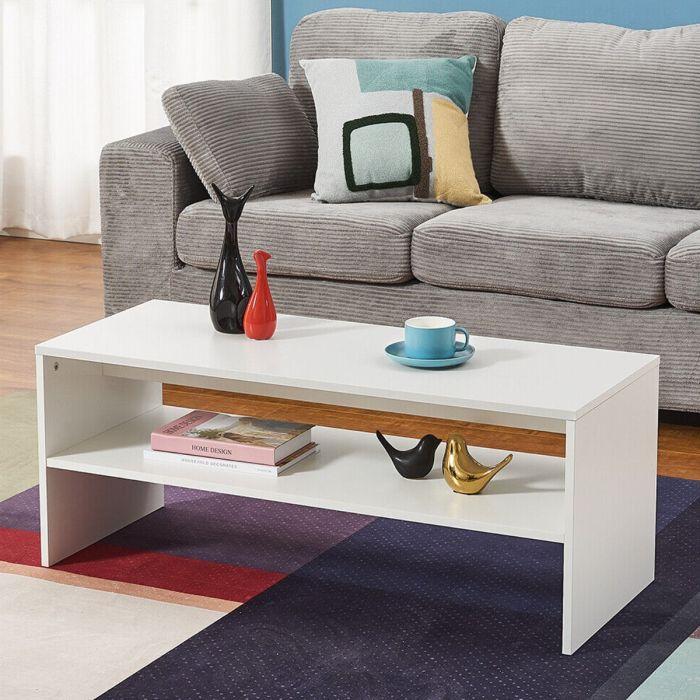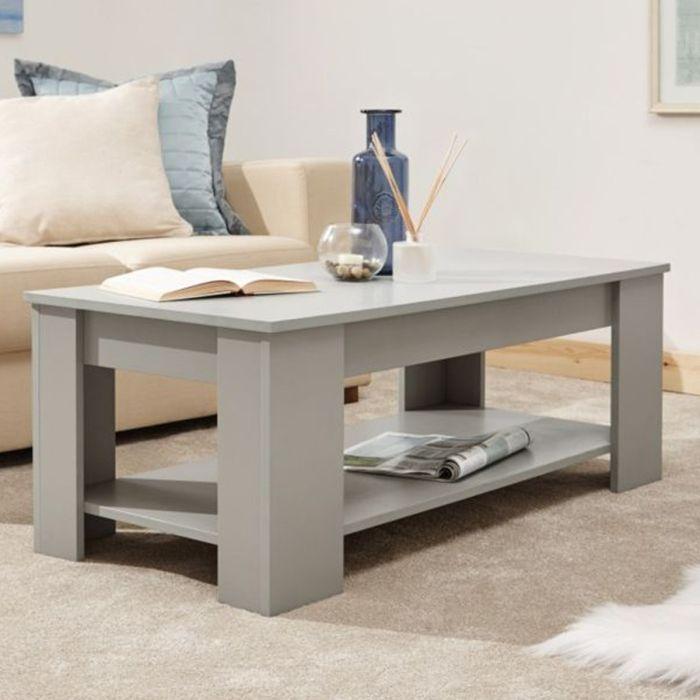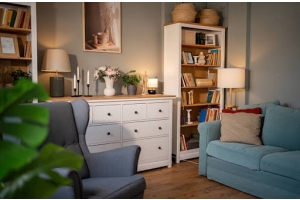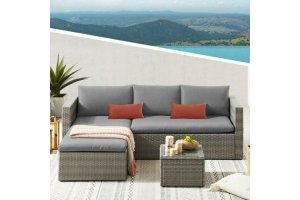
A coffee table is a versatile piece of furniture that plays a pivotal role in both living rooms and bedrooms, enhancing both functionality and decor. Its decorative value is undeniable, offering a central point of focus around which the rest of your room’s design can revolve. Beyond its aesthetic appeal, a coffee table is incredibly practical—it serves as a convenient surface for storing items, displaying decorative accents, or providing a spot for guests to set down food and drinks during gatherings. In a bedroom setting, it transforms into a handy piece of furniture for everyday use, whether holding essentials or adding a touch of elegance to the space.
Choose Right Size Of Coffee Table
Choosing the right coffee table involves more than just picking a stylish piece; it’s about finding one that suits your specific needs and complements your room’s decor. In this blog, we’ll explore how to select the perfect coffee table by considering its height, style, and decorative possibilities, ensuring it enhances both the functionality and aesthetics of your space.

Height
When selecting a coffee table, its height plays a pivotal role in ensuring both comfort and functionality within your living space. The standard coffee table height typically falls between 40cm and 45cm, aligning with the height of most sofas for optimal usability. To achieve a harmonious look and practical use, your coffee table should ideally be roughly equal to the height of your sofa cushions or armrests.
For the most comfortable experience, aim for a coffee table height that is within 5 cm of your sofa’s height. This guideline helps ensure that you can easily reach for items on the table without excessive stretching or bending. If your sofa is unusually high or low, you may need to adjust the table height accordingly. For instance, a higher sofa might pair well with a taller table, while a lower sofa could benefit from a shorter table. By adhering to this coffee table height guide, you’ll create a well-balanced and functional living area that enhances both the aesthetic and practical aspects of your space.
Length
Choosing the right length for your coffee table is key to achieving a balanced and functional living area. Ideally, the length of your coffee table should correspond with the size of your room and the dimensions of your sofa. As a general guideline, aim for a coffee table that measures approximately half to two-thirds the length of your sofa. This proportion helps maintain a cohesive look without overwhelming the space.
In terms of specific measurements, standard coffee tables typically range from about 70 cm to 220 cm in length, with many averaging around 120cm. When selecting your table, be sure to consider the overall dimensions of your room and the scale of your furniture. A coffee table that is too long can crowd the space, while one that is too short may look out of place. By opting for a table that is in harmony with the length of your sofa, you ensure a visually pleasing arrangement that enhances both the functionality and aesthetic of your living area.
The Best Shapes for Coffee Tables

Coffee table should be chosen on the basis of both your room's layout and your personal style. Each shape offers unique advantages and can enhance your space in different ways:
- Rectangular: The most popular choice, rectangular coffee tables, work well with longer sofas and traditional decor. Their extended shape makes them ideal for larger spaces and can help balance out longer seating arrangements. Rectangular tables are also great for breaking up the monotony of soft, rounded lines in a room.
- Square: Square coffee tables provide a balanced look that suits smaller rooms or spaces with similarly shaped seating arrangements. They offer a symmetrical aesthetic and are particularly well-suited for modern interiors where clean lines are desired.
- Round: Round coffee tables are a perfect fit for shorter sofas and more compact seating areas. They eliminate sharp corners, making them a practical choice for homes with young children or pets. The round shape can also soften the overall look of a room filled with angular furniture.
- Oval: For those who appreciate the round table’s aesthetic but need a larger surface to complement a longer sofa, an oval table offers a chic solution. Its elongated shape provides ample surface area while still maintaining the softness of rounded edges.
- Geometric: Tables with unconventional shapes like triangles, hexagons, or half-circles can add a touch of creativity to a space. These geometric designs work well in casual, eclectic settings and can function as a statement piece that doubles as art.
- Free-form: If your living area boasts a modern and sophisticated vibe, a free-form coffee table can serve as both a functional piece and an artistic element. Its abstract shape adds a unique visual interest and fits seamlessly into contemporary decor.
Coffee Table Materials - A Overview
The material of the coffee table, though, seems insignificant but it can significantly impact the look and feel of your space. Each material offers distinct advantages and aesthetic qualities, catering to various styles and functional needs.
- Glass: Glass coffee tables are a popular choice for smaller or cramped spaces due to their transparent nature, which helps create an illusion of more space. They offer a sleek and modern look and are easy to maintain with simple wipe-clean surfaces. Glass works well with a variety of decor styles but can be prone to fingerprints and requires regular cleaning to maintain its clarity.
- Wood: Wooden coffee tables bring warmth and texture to any room. Oak is highly sought after for its timeless, rustic appeal, providing a sturdy and classic option that complements traditional decor. Walnut, with its rich, deep tones, adds a touch of sophistication and grandeur. Wood’s natural grains and finishes can enhance a space’s character and match well with a variety of furnishings.
- Marble, Granite, and Slate: These materials offer a luxurious and dramatic contrast to spaces, especially when paired with hardwood floors or muted rugs. Marble and granite provide a high-end, elegant appearance and are incredibly durable. However, they can be heavy and require regular sealing to prevent stains. Slate, while also durable, offers a more rugged texture that can add a unique touch to your decor.
- Plastic or Acrylic: Lightweight and versatile, plastic or acrylic coffee tables are perfect for minimalist settings. They are easy to move around and clean, making them a practical choice for dynamic spaces. Their transparent or colourful designs can inject a modern or playful element into your decor.
- Metal: Metallic coffee tables are known for their strength and durability. They come in various finishes, such as mirrored chrome or brushed steel, which offer a chic and contemporary look. Metal tables are robust and can support heavier items while adding a sleek, modern touch to your room.
How to Make Choice: The best material for your coffee table ultimately depends on your specific needs and the overall style of your space. For a timeless, versatile option, wooden tables—particularly oak or walnut—stand out as the most enduring choice. They combine durability with classic appeal and can adapt to various interior styles, from traditional to contemporary. If your priority is a modern, low-maintenance table that enhances a small room, glass or acrylic would be ideal. For those seeking luxury and durability, marble or granite tables provide an elegant statement piece.
Look for Versatility

Beyond their primary function as a surface for drinks and decor, coffee tables can offer a wealth of versatility to enhance your living space. Here are some features to consider that can transform your coffee table into a multifunctional asset:
- Storage Solutions: Many coffee tables come equipped with built-in drawers, bins, or shelves. These additions are perfect for storing everyday items like magazines, remote controls, or coasters. For a tidy and clutter-free living area, tables with these features allow you to keep essential items within reach but out of sight.
- Trunk Tables: With a lidded top that opens to reveal a spacious interior, it provides ample storage for blankets, books, or seasonal decorations. These tables often have a vintage or rustic appeal, adding character to your room while offering hidden storage.
- Ottomans: Coffee tables with an ottoman design offer both comfort and utility. Upholstered in soft fabric, they can double as extra seating or a footrest. Some ottoman coffee tables also feature storage compartments beneath the upholstery, blending style with functionality.
- Mobility: Coffee tables with wheels are ideal for those who frequently rearrange their space. The wheels make it easy to move the table from one spot to another, accommodating changes in your layout or making room for special events.
- Adjustable Heights: Some coffee tables come with adjustable height features, allowing you to modify the table’s height according to your needs. This can be particularly useful if you need a table that can transition from a standard coffee table height to a higher level for dining or working.
- Convertible Designs: Tables with convertible features can transform from a coffee table into a dining table or a desk. These versatile designs are excellent for multifunctional rooms or smaller spaces where flexibility is key.





